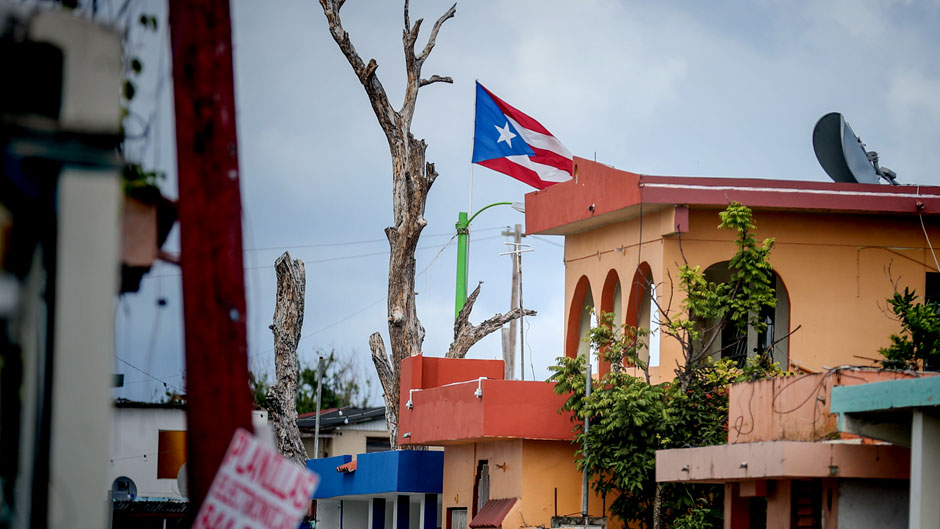The waist-high floodwaters inside the elderly couple’s one-story home were still rising. Outside, in an overcast early-morning sky, Hurricane Maria raged on, pummeling the small village of Punta Santiago, Puerto Rico, with 155 mile-per-hour winds and a powerful storm surge.
But Noelia Rodriguez and Francisco “Paco” Lopez Riva weren’t ready to die. With all the strength she could muster, Noelia helped her ailing 80-year-old husband onto a couch that had miraculously stayed afloat in their living room, using one hand to make sure he didn’t fall off and the other to cling to the side of the piece of furniture. For the next eight hours, it would be their lifeboat.
“She told me that if she would let me go, she would also let go,” Francisco recalled of their ordeal on the day Maria struck.
Today, nearly nine months after Maria became the strongest cyclone to hit the U.S. territory in nearly a century, Noelia, Francisco, and thousands of other residents of this beachfront community in Humacao, Puerto Rico, are still reeling from the storm’s effects. Unemployment is up. Many homes remain damaged. And elevated rates of post-traumatic stress disorder, depression, and anxiety have been reported.
Punta Santiago, Puerto Rico, Six Months After Maria from Carl Kafka on Vimeo.
Those are just some of the findings of a needs-assessment study conducted by two graduate students in the University of Miami Miller School of Medicine’s Department of Public Health Sciences who traveled to Punta Santiago last March to document the plight of residents there.
“Punta Santiago is only one community, but hopefully our study can shed light on what’s happening in other marginalized areas that are still suffering after the hurricane,” Isabella Ferré said of the exhaustive report for which she and Stephanie Negrón spent a week in Puerto Rico gathering information.
Impassable roads, downed phone lines and damaged cellphone towers left Punta Santiago virtually cut off from the outside world. Food, freshwater and other essentials for the community’s 5,000 people were scarce, prompting one resident to write “Necesitamos comida, agua” [We need food, water] in large letters across the intersection of a roadway in hopes that a plane would spot it.
Ferré, who is Puerto Rican on her father’s side, became aware of the dire conditions in Punta Santiago after volunteering with a nonprofit organization last December, January and February to help the island’s hurricane victims. “The people felt abandoned, written off—that the outside world had forgotten about them,” she said.
When Ferré returned to Miami from one of her volunteer trips to the island, she made up her mind to do a study to identify the neighborhood’s needs, and sought advice from Miller School public health researchers on how to conduct such an investigation. Negrón, who was born in Humacao and still has family there, asked to help.
So the two flew into Puerto Rico last March to start a weeklong survey of Punta Santiago’s residents, rising before dawn each day to drive to the neighborhood on decimated roads still difficult to navigate.
What they experienced with each interview they conducted were townspeople “willing to open up to us, willing to tell their stories, even to two strangers who didn’t live on the island, and to offer us whatever food they had,” Ferré recalled.
Townspeople like Noelia and Francisco, who suffers from Guillain-Barré syndrome, a disorder in which the body's immune system attacks part of the peripheral nervous system. “I wept after hearing their story,” said Ferré.
And the old woman whose husband died of a heart attack two days after the hurricane hit—his body laying in her house for days because she couldn’t get word out for help.
Ferré and Negrón are well aware of the recent Harvard study that reported residents of Puerto Rico died at a significantly higher rate during the three months after Hurricane Maria than they did in the previous year. For their needs-assessment study, Ferré and Negrón did not attempt to determine the number of deaths in Punta Santiago that could be directly attributed to the hurricane.
James M. Shultz, director of the Center for Disaster and Extreme Event Preparedness and a voluntary associate professor of public health sciences, calls Ferré and Negrón’s study “critically important for documenting the extent of the unrelenting adversities experienced by residents of Puerto Rico.”
“As an outcome of their work, we are able to seek out evidence-based interventions and other lifelines for these storm-affected populations,” he said.
Ferré and Negrón’s findings, along with separate study results on air and water quality in Punta Santiago post-Hurricane Maria, were presented at a symposium on the Miller School campus last month. The project’s second phase, which involves implementing solutions, is now underway.
Like her grandfather, Maurice Ferré, a former six-term mayor of Miami who was the first Puerto Rican-born U.S. mayor, and her great aunt, Isolina Ferré Aguayo, who was known as the “Mother Teresa of Puerto Rico” and received the Presidential Medal of Freedom for her humanitarian work, Isabella Ferré wants to help make a difference—in this case, in the lives of Punta Santiago’s residents. “I want to give them hope,” she said.

